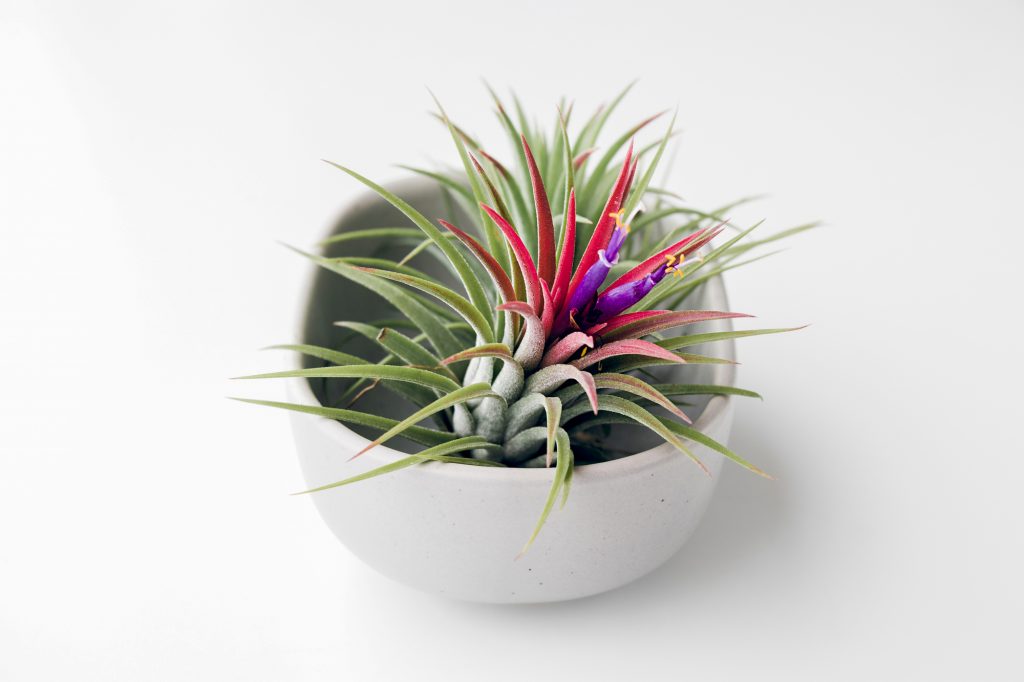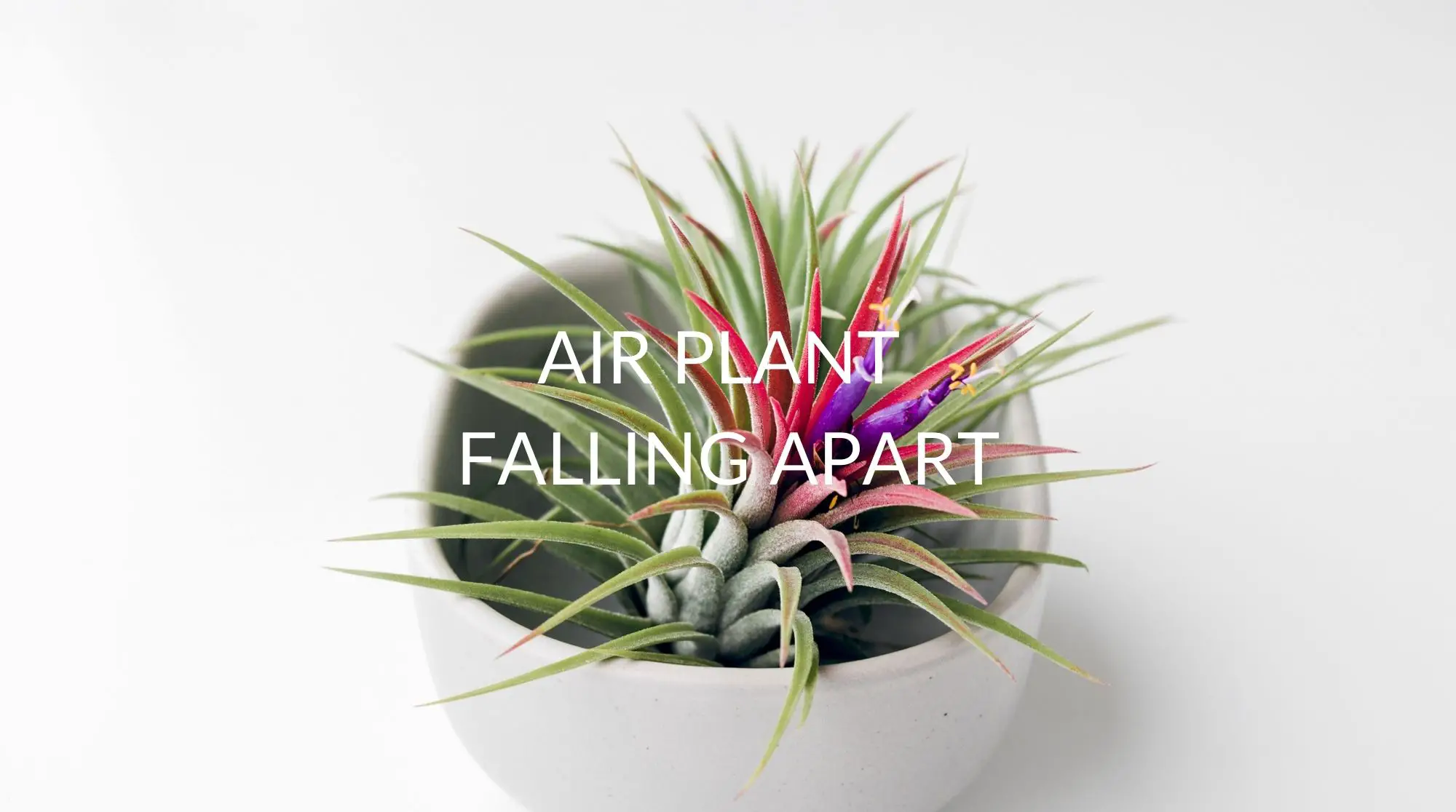If your air plant is decaying, it might be rotting, overwatered, have a lack of light, air exchange, or be exposed to an improper environment. The first stage in reviving your air plant is determining the source of the disease to take appropriate action to repair the condition.
Continue reading to learn more about why your air plants are falling apart, whether your air plant is rotting, why your air plant may be falling apart, how to revive your plant, and more.
Is My Air Plant Rotting?
Rotting starts at the roots of most plants, which are underground. The decaying takes place under the surface, where it is initially disguised. When the rot spreads to the stem and lower leaves, you’ll notice it. The decaying roots will no longer be able to absorb nutrients and water, and the foundation will collapse.
The decaying process takes a different turn with air plants because they don’t have root systems and are above ground. Internal or external rot can affect air plants. Externally, the plant is decaying if its leaves acquire brown or black damp patches or the base darkens. If you don’t catch it early on, the rot will spread to the plant’s interior sections, causing it to fall apart.
Leaves Beginning Turning Yellow and Colourless
When an air plant has succumbed to root rot, its leaves begin to lose their colorful flair. Their green hues will start to turn yellow and eventually appear colorless before dying if no action is taken.
Is Your Air Plant Soft or Spongy?
Air plants are never meant to feel soft or spongy. If your air plant develops either of these traits, it may be suffering from a form of rot.
Base Leaves Begin to Darken
As the base leaves of your air plant begin to get taken over by root rot bacteria, they can darken before falling off. If your air plant’s base leaves appear to be darkening, act immediately to remove the rot before the plant dies entirely.

Why Is My Air Plant Falling Apart?
If your air plant is wilting, it has most likely developed damp rot at the base as a result of overwatering. It might also be caused to a lack of light and air exchange or exposing an air plant to rainy circumstances.
Root Rot in Air Plants
If your air plant appears brown or feels soft or mushy, it has most likely obtained root rot. A decaying air plant may lose leaves at its bottom and may begin to fall apart, or the air plant’s core may come out. Inner rot is difficult to detect since it usually goes undetected until the plant comes apart one day, generally starting with the interior leaves.
Outer leaf rot and fungal concerns are significantly more visible than interior leaf rot. Dark stains on the plant’s base may appear, spreading over time. In this case, removing the diseased leaves from the plant’s base to stop the rot from spreading is the best way to rescue the plant.
Overwatering
Overwatering is one of the most prevalent causes of air plant degeneration. While overwatering isn’t a common problem with air plants, retained water is the primary source of worry. Air plants usually accept as much water as they require when watered by soaking.
You are unlikely to have problems if you remove your air plants from the water, allow them to dry, and then display them regularly. However, rot can occur if you have just watered your air plant and retained water is left behind between the leaves.
After you’ve watered your plants, shake off any leftover water and let your air plant to dry. Lay it on a tissue to dry, flipping it after 10 minutes to allow each side to dry. Hang your air plants upside down to allow all of the water to flow down.
The trick is to allow it to dry as soon as possible. It’s possible that leaving water trapped for any length of time can harm your plant. Air plants must be completely dry after 3-4 hours.
Lack of Light
Low light or temperature are two more reasons why your air plants could have a fungal infection or decay. For example, Tillandsias demands medium to high light levels as well.
Also, while displaying air plants, make sure that all of the plant’s components get enough light. Air plants should not be buried in deep pots since the leaves at the base will become brown and fall off. as warm temperatures. Low light might cause your air plant to wilt and lose its leaves.
Otherwise, your air plant may not entirely dry out and begin to wither. The ideal temperature for air plants at home is 60-80 degrees Fahrenheit. However, if the temperature drops below 50 degrees Fahrenheit or rises beyond 95 degrees Fahrenheit, seek a warmer spot and provide shade to your plant.
If your Air plant is turning red, however, here are some reasons why it’s happening.
Lack of Air Exchange
When there isn’t enough air exchange, the air becomes moist and stagnant. Tillandsias, for example, thrive in humid environments. The same may be said for green mesic air plants found in rainforests. They do, however, have sufficient air exchange in their native environment, even if the humidity is excessive.
Air exchange is significantly reduced at home. As a result, if you’ve overwatered the plant and there’s no sufficient air exchange, it may begin to decay. On the other hand, Air plants benefit from appropriate ventilation and wind. So, at home, make sure the space where your plant is kept is well ventilated. You may also take it outside as much as possible, and it will love it.
Environmental Exposure
You may exhibit your air plants in a variety of ways. Always ensure that the display surface is dry. Air plants should not be placed or mounted on moist soil, wet coconut fiber, wet moss, or bark chips, for example.
Your air plant will decay if placed on a moist or wet substrate. Since air plants’ roots do not absorb water, the bottom of the plant should be kept dry. Tillandsia xerographica, for example, has a large base that can readily gather water and decay.
Can You Revive an Air Plant that’s Falling Apart?
Unfortunately, there isn’t much you can do if your air plant is dying. On the plus side, if the air plant rot is limited to the outer leaves, you may be able to salvage the plant by removing the diseased leaves and adhering to a rigorous watering and drying regimen.
It all boils down to watering, or more particularly, drainage when an air plant is dying of rot. Air plants need to be misted or soaked in water to be alive, but they don’t want to be wet. It’s essential to let the plant dry once it’s been wet or misted. If the plant’s core remains damp, the fungus will take hold, and the plant will die.
After you’ve finished watering your air plant, tilt it so it can drain and allow it for four hours to completely dry. This may be done using a dish drainer or by upending the plant on a dishtowel.
How Do You Fix an Air Plant Falling Apart?
Trim or Get Rid of Any Dead Leaves
Taking out any dead leaves is a super-easy and natural way to preserve an air plant that has begun to fall apart. Allowing your air plant to cling to the deceased or disease leaves can hinder air circulation and sunlight absorption.
When dead leaves are removed, this allows for stronger ones to emerge. This is critical because air plants acquire nutrients and moisture from the environment. You could even discover that simply removing the dead leaves was all that was required to bring the plant back to life.
However, you’re in for some terrible news if pulling causes the entire plant to come apart. If this happens, your air plant may have already perished. Looking for green, healthy leaves on the plant is the key to reviving it. The air plant will most likely have to be discarded if there aren’t any.
Ensure that your Air Plant Receives Adequate Ventilation
Proper ventilation will aid with temperature and humidity control. Air plants do not fare well in small rooms, confined terrariums, or cramped spaces. Inside, they produce a humid and moist atmosphere. The air plant is never allowed to dry out completely, promoting wet rot.
If this is the case, move the air plant to a more open location. Turn on the air conditioner or fans if you have them. You may also use small USB fans or desk fans to help circulate air around your air plants.
How To Prevent Air Plants from Falling Apart?
Air Plants Should Never Be Overwatered
Maintain a watering regimen and avoid overwatering. Remember that Tillandsias are distinct from many other house plants in that they take in moisture through their leaves and trichomes rather than their roots and can be overwatered, promoting root rot.
Remove Any Excess Moisture on Plants After Watering
After watering, shake away any leftover water from your air plant and allow it to dry thoroughly before reintroducing it to your terrarium, shell, or anywhere else you’ve placed it. Air plants should not be sprayed or allowed to sit in water in their terrariums.
Don’t Soak Your Air Plant Overnight
Never submerge an air plant in water for an extended length of time. Keep in mind that some air plants should not be submerged in water, especially if you live in a humid region. Also, never place your air plant on a damp bed; instead, wait until it is totally dry before placing it back on display.
Recap
Air plants are quite simple to maintain as long as they are not overwatered and receive proper light, ventilation, and exposure to the appropriate environment. If your air plant starts to come apart, it might be missing in one of these areas or infected with root rot. To rescue your air plant, try removing the afflicted region and keeping track of your watering habits.
Root rot is, unfortunately, one of the most common air plant ailments, and it may be challenging to treat. Paying attention to these minor aspects of nature, on the other hand, can aid in the early detection of any ailment, making it easier to treat.
Keep in mind that different air plants require varying amounts of water, but none should be immersed for long periods. Finally, if your air plant is in a terrarium or other container, keep the top open to allow for proper air circulation and reduce the risk of rotting.

